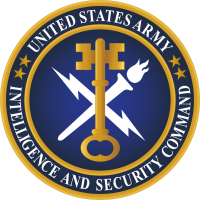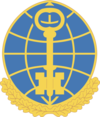Loading AI tools
U.S. Army direct reporting unit From Wikipedia, the free encyclopedia
The United States Army Intelligence and Security Command (INSCOM) is a direct reporting unit that conducts intelligence, security, and information operations for United States Army commanders, partners in the Intelligence Community, and national decision-makers. INSCOM is headquartered at Fort Belvoir, Virginia.
| U.S. Army Intelligence and Security Command | |
|---|---|
 Unit logo | |
| Active | 1977–present |
| Country | |
| Branch | |
| Type | Direct reporting unit[broken anchor] |
| Role | Military intelligence, Information operations |
| Size | 10,000+[1] |
| Headquarters | Fort Belvoir, Virginia |
| Nickname(s) | INSCOM |
| Website | Official website |
| Commanders | |
| Current commander | MG Timothy D. Brown |
| Chief Warrant Officer | CW5 Jeremy M. Sager |
| Command Sergeant Major | CSM Kyle J Gillam |
| Insignia | |
| Shoulder sleeve insignia |  |
| Distinctive unit insignia |  |
INSCOM contributes units to the National Security Agency, the United States's unified signals intelligence (SIGINT) organization. Within the NSA, INSCOM and its counterparts in the Navy, Air Force, Space Force, Coast Guard, and Marine Corps comprise the Central Security Service. INSCOM's budget has been estimated to be approximately $6 billion.[2]
As a direct reporting unit[broken anchor], INSCOM reports directly to the Chief of Staff of the Army.
INSCOM collects intelligence information in all intelligence disciplines to provide unit commanders with intelligence for the battlefield and the focus of combat power. The organization also conducts intelligence production activities, ranging from intelligence preparation of the battlefield to situation development, SIGINT analysis, imagery exploitation, and science and technology intelligence production. INSCOM also has significant responsibilities in counterintelligence, force protection, electronic warfare, and information warfare. Additionally, INSCOM supports force modernization and training.

INSCOM's stated vision for operations includes: (1) conducting and supporting relevant intelligence, security and information operations for U.S. Army, joint and combined forces; (2) optimizing national/theater/tactical partnerships; (3) exploiting leading edge technology; and (4) meeting the challenge of today, tomorrow and the 21st Century.
On 1 January 1977, the United States Army Intelligence and Security Command (INSCOM) was organized at Arlington Hall Station, Virginia, to provide the U.S. Army with a single organization for conducting multi-discipline intelligence, security operations, and electronic warfare at the level above corps. The new organization merged the former U.S. Army Security Agency, the signal intelligence and signal security organizations previously located at Arlington Hall, Virginia, the U.S. Army Intelligence Agency, a counterintelligence and human intelligence agency based at Fort Meade, Maryland, and several intelligence production units formerly controlled by the Assistant Chief of Staff for Intelligence and U.S. Army Forces Command. Brigadier General (later Major General) William I. Rolya, former commanding general of the Army Security Agency, became INSCOM's first commanding general.[citation needed]
On 1 October 1977, the former U.S. Army Intelligence Agency headquarters was integrated into INSCOM. The command established a unified intelligence production element, the Intelligence and Threat Analysis Center, on 1 January 1978. Additionally, INSCOM assumed command of three military intelligence groups located overseas: the 66th Military Intelligence Group in Germany, the 470th Military Intelligence Group in Panama, and the 500th Military Intelligence Group in Japan. These groups were transformed into multidisciplinary units by incorporating former Army Security Agency assets into the previously existing elements. A fourth such group, the 501st Military Intelligence Brigade,[5] was soon organized in South Korea. All of these groups were eventually reorganized and re-designated as brigades.[citation needed]
In association with the Defense Intelligence Agency, and under the leadership of commanding general Albert Stubblebine, INSCOM attempted to use parapsychologic methods such as remote viewing in operation Center Lane. This was done as late as 1981. Other U.S. intelligence services attempted similar projects during the same period, most notably the Stargate Project by the Central Intelligence Agency.[citation needed]
| No. | Commanding General | Term | |||
|---|---|---|---|---|---|
| Portrait | Name | Took office | Left office | Duration | |
| - | Major General David B. Lacquement | 2007[7] | 16 October 2009 | ~2 years, 288 days | |
| - | Major General Mary A. Legere | 16 October 2009[8] | 5 March 2012 | 2 years, 141 days | |
| - | Major General Stephen G. Fogarty | 5 March 2012[9] | 30 May 2014 | 2 years, 86 days | |
| - | Major General George J. Franz III | 30 May 2014[10] | 27 June 2016 | 2 years, 28 days | |
| - | Major General Christopher S. Ballard | 27 June 2016[11] | 11 June 2018 | 1 year, 349 days | |
| - | Major General Gary W. Johnston | 11 June 2018[12] | 16 July 2021 | 3 years, 35 days | |
| - | Major General Michele H. Bredenkamp | 16 July 2021[7] | 14 December 2023 | 2 years, 151 days | |
| - | Major General Timothy D. Brown | 14 December 2023 | Incumbent | 322 days | |
Seamless Wikipedia browsing. On steroids.
Every time you click a link to Wikipedia, Wiktionary or Wikiquote in your browser's search results, it will show the modern Wikiwand interface.
Wikiwand extension is a five stars, simple, with minimum permission required to keep your browsing private, safe and transparent.